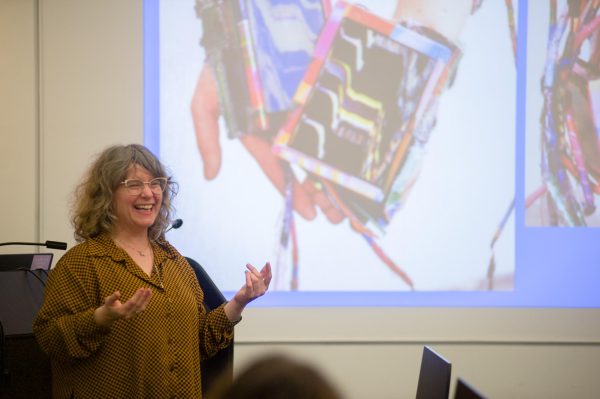Perspectives: Seeing Myself in a 350-Year-Old Portrait
Wide eyes. An ambiguous look over her right shoulder. Slightly parted lips. A lone pearl earring. I love art, but I have a rather complicated relationship with Johannes Vermeer’s iconic Girl with a Pearl Earring.
While researching 17th century Dutch art for a project back in high school, I stumbled upon a close-up image of the painting, and was intrigued by the subject’s piercing, yet seemingly apathetic gaze. Tracing the line of her cheek on my computer screen, I saw a resemblance between us. Yet, we would never be the same. Whereas she was quietly confident, I felt insecure about my future. At the time, the mere thought of college overwhelmed me; I had no idea where I would spend the next four critical years of my life. I felt envious towards her — I wished it were I, and not she, forever ingrained in a medium so permanent and everlasting as a portrait. Unable to contain my jealousy, I read her expression as snide.
A few months later, while searching through the 10-cent rack at my local library, I was faced again with the haunting expression of the painting’s subject on a book’s cover. I had found an old, dog-eared copy of Oberlin class of 1984 alumna Tracy Chevalier’s novel, Girl with a Pearl Earring (1999), and decided to give it a chance. That night, I sat down and began reading.
I found myself drawn in by the novel’s themes of sacrifice and artistic vision. Although the novel is fiction, Chevalier’s novel paints a vivid image of the girl in the portrait’s life and the world that she navigated. Forced to be subservient to those of a higher class, taught to obey men at all costs, Vermeer’s Girl had none of the opportunities I have. After reading the novel, I again gazed at the painting. I noticed that she no longer looked snide, but rather weary — as if warning me against living my life as she was forced to.
Reading the novel allowed me to transcend time and space, to empathize with an individual, albeit a fictional one, who overcame great odds. The girl, Griet, serves as the lowly help of the artist Johannes Vermeer and his family. Throughout the novel she is sexually assaulted, verbally abused, and loses a close family member, but eventually finds solace in studying Vermeer’s delicate balance of light and dark in his paintings. She forms a familial bond with her superior, who hires her as his artistic assistant and paint mixer. Art becomes both a means of escape and a vehicle to work through her problems.
In other words, instead of succumbing to the suffocating pain of her life experiences, she chooses to create.
Six years ago this October, when I was 13, I stood knee-deep in rapidly-rising, freezing water as Hurricane Sandy brought over five feet of brackish water into my home. For my family and our neighbors, the consequences of the storm — which largely came as a surprise — have been trying and far-flung. After not living in my home for nearly a year after Sandy, I returned to my neighborhood to find that it was still in various stages of abandonment and neglect. A few years later, after one of my parents was diagnosed with cancer and underwent several surgeries and aggressive rounds of chemotherapy and radiation, I couldn’t help but feel like the stress from the storm — and all the toxins unearthed from the construction — caused it.
In addition to the physical destruction of Sandy, the storm amplified existing troubles in my family. Last summer, I was out of the house a lot — admittedly because my family situation felt so miserable and hopeless. I found myself extending my work days in New York City by venturing to museums after my internship to escape the noise and stress that characterized my home life.
But Girl with the Pearl Earring shows us that ignoring the problem leads to greater consequences later on. I believe this sentiment, and recently, I’ve tried to face my problems head on with courage and tenacity rather than avoidance. I’ve started to realize that I am in charge of my future — as if I am holding a paintbrush to an empty canvas.
This column concludes my time as co-editor of the Arts & Culture section of The Oberlin Review. I am incredibly grateful for the hardworking writers that cover the diverse arts scene at Oberlin, and for the editors and staff at the Review that make the incredibly stressful endeavor of publishing a weekly paper wildly fun. Creating a journalistically-sound publication in a time where fake news and social media abound is no small task, and the staff of the Review takes on this challenge with unbeatable grace. In particular, writing and editing for Arts deepened my appreciation for the limitless artistic talent of Oberlin students — even during times of great stress, the art that my fellow students put out into the world constantly serves as a reminder of how beautiful life can be.
Next semester, I will be studying abroad in Amsterdam, a city I’ve always dreamed of visiting and one that is less than an hour away from where Vermeer’s Girl with a Pearl Earring is currently on display. I’m excited for the cultural experiences I’ll have next semester and enormously grateful for the opportunity to travel and live in a new place.
Ultimately, I know that no matter what I’ll do or where I’ll go, I will make sure I visit Vermeer’s Girl and tell her thanks for everything.










